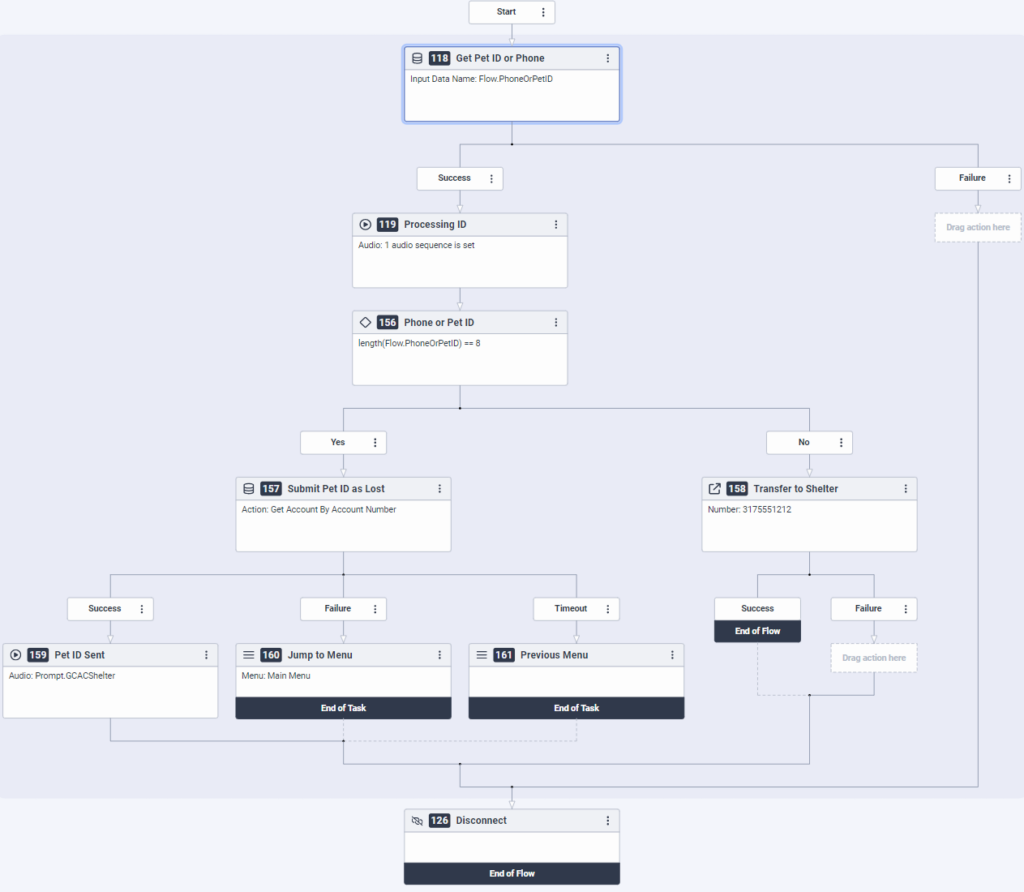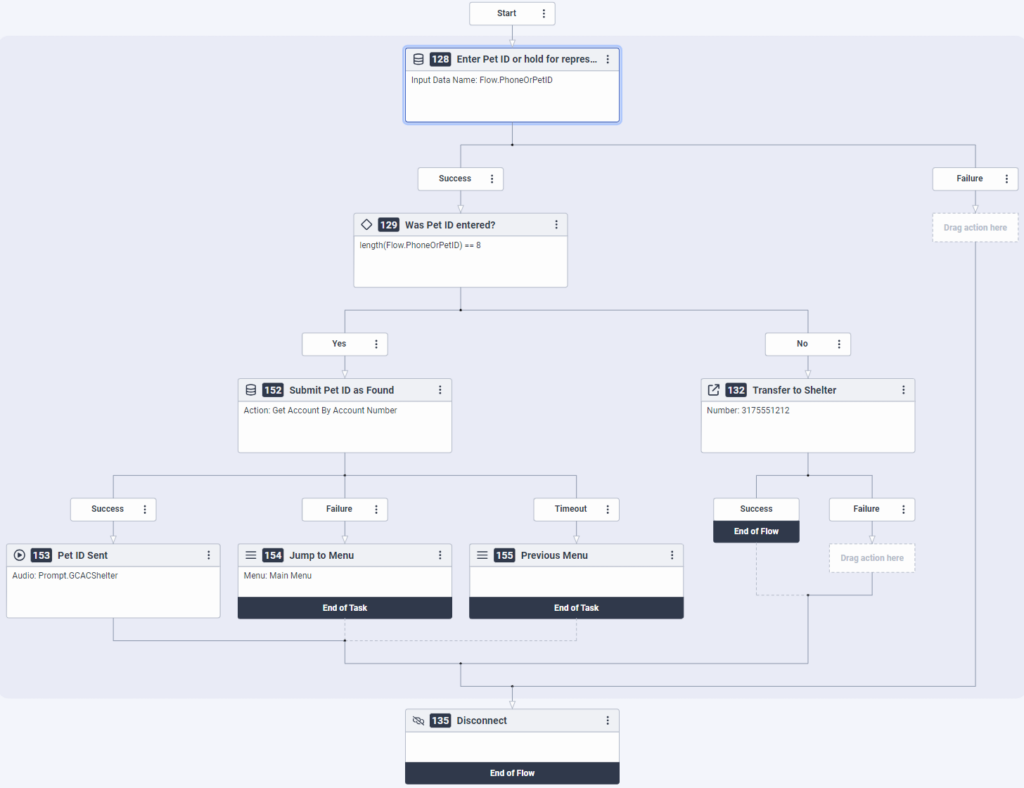Series: Architect tutorial for beginning users
Lesson 3: Create reusable tasks for lost and found pets
- Lesson 2: Create the initial flow and add menus
- Lesson 1: Create and upload audio prompts
- Lesson 2: Create the initial flow and add menus
- Lesson 4: Create a reusable task for pet tracking services
- Lesson 5: Organize the starting menu structure
- Lesson 6: Call flow default configuration
- Lesson 7: Add a language and language menu
- Lesson 8: Validate and publish the Genesys Cloud Animal Care call flow
- Lesson 4: Create a reusable task for pet tracking services
In this lesson, you continue setting up actions that you will eventually add to the Main Menu.
Objectives
- Create lost and found pet reporting reusable tasks.
- Add task actions to collect information from the caller and determine where to send the call, based on input.
- Continue the flow path using data actions to obtain caller information.
Estimated time to complete: 25 minutes
Prerequisites
- Ensure that your administrator created and configured a working data action. For more information, see Add a data actions integration.
- Complete lessons 1–2.
- Review Work with tasks.
- Have a telephone number appropriate for tutorial testing, such as a mobile phone or direct line, to which you can transfer calls.
Additional resources
Tasks
In this section, you create reusable tasks that give callers the option to access the Pet Lost and Found menu to report a lost or found pet. Using Pet ID information collected from the caller, Architect passes the data to an external system using a data action. Architect requires a data action to pass data collected in an IVR to an external system.
- From the Toolbox, expand the Task category and drag a Task action into the Reusable Tasks area.
- In the Name box, type Lost pet and then click Done.
- From the Toolbox, expand the Data category and drag a Collect Input action to just below the Start menu and complete the following tasks:
- In the Name box, type Get Pet ID or Phone.
- In the Input Audio box, type Prompt.GCACPetID.
- In the Input Data Name box, type Flow.PhoneOrPetID.
- In the Number of Digits areas, click change to range.
- Move the digit sliders until the Range of Digits reads Any number of digits between 8 and 10, inclusive.
- Leave the remaining settings unchanged.
- Expand the Audio category and drag a Play Audio action below the Get Pet ID or Phone action’s Success path and do the following:
- In the Name box, type Processing ID.
- Click the Edit Audio Sequence button at the end of the Audio box. The Edit Audio Sequence dialog box opens.
- Click Add TTS and in the Text To Speech box, type Thank you. Please wait while we process your account request.
- Click Add blank Audio and in the Blank audio field, leave the default blank audio unchanged.
- Click Close.
Add a Decision action to the flow that decides the path the call takes, depending on whether the caller entered an 8-digit Pet ID, or a 10-digit telephone number. Use the following expression:
length(Flow.PhoneOrPetID) == 8
Based on the expression as written, if the entry is eight digits, then Architect matches the ID to the account via a previously created data action. If the entry is not eight digits, then Architect transfers the call to the Reporting office, where the caller can speak with a Genesys Cloud Animal Care representative.
- Expand the Logical category and drag a Decision action into the task editor below the Processing ID action.
- In the Name box, type Phone or Pet ID.
- In the Expression area, click the Expression modes button and select Expression button to switch to expression mode. The box changes to allow expression entry.
- In the Expression box, type length(Flow.PhoneOrPetID) == 8.
If the caller entered an 8-digit number, then Architect retrieves the customer’s account information, matches it to the Pet ID, and checks the pet as lost. If the customer did not enter a valid Pet ID, then Architect transfers the caller to Genesys Cloud Animal Care’s pet shelter, where a representative personally collects the caller’s information.
- From the Toolbox, expand the Data category, drag a Call Data Action below the Phone or Pet ID action’s Yes path, and complete the following steps:
- In the Name field, type Submit Pet ID as Lost.
- Click the arrow at the end of the Category list and select the category that contains the data action.
- Click the arrow at the end of the Data Action list and select the data action that contains the Pet ID database.
- In the Inputs area, a field for account number entry or equivalent appears. Type Flow.PhoneOrPetID, which holds the caller’s entered information.
- From the Toolbox, drag a Play Audio action below the Submit Pet ID as Lost action’s Success path and complete the following steps:
- In the Name box, type Pet ID Sent.
- In the Audio box, type prompt.GCACShelter.
- From the Toolbox, expand the Transfer category and drag a Transfer to Number action below the Phone or Pet ID Decision Action’s No path and complete the following steps:
- In the Name box, type Transfer to Shelter.
- In the Pre-Transfer Audio box, type prompt.GCACRepresentative.
- Add your choice of TTS for failed transfer audio.
- In the Number box, type a telephone number appropriate for tutorial testing, such as your mobile phone or direct line.
- From the Toolbox, expand the Menu category, drag a Jump to Menu action below the Submit Pet ID as Lost action’s Failure path, and select the Main Menu.
- From the Toolbox, expand the Menu category and drag a Previous Menu action below the Submit Pet ID as Lost action’s Timeout path.
- From the Toolbox, drag a Disconnect action below the Pet ID Sent action.
- Click Return to Overview.
Practice
Following similar strategy used in the Tasks section, create a Found Pet reporting task.
- Name the reusable task Found Pet.
- Add a Collect Input action to the task and do the following:
- Name the action Enter Pet ID or hold for representative.
- Add the Prompt.GCACPetID prompt.
- Use Flow.PhoneOrPetID as input data.
- Use a range of digits between 8 and 10 inclusive.
- Leave the remaining settings unchanged.
Add a Decision action to the flow that decides the path that the call takes, depending on whether the caller enters an 8-digit Pet ID, or a 10-digit telephone number. Complete the following steps:
- Name the action Was Pet ID entered?
- Switch to expression mode and add the following expression: length(Flow.PhoneOrPetID) == 8.
- Add a Call Data Action below the Was Pet ID entered? action’s Yes path and complete the following steps:
- Name the action Submit Pet ID as Found.
- Select the category that contains the data action.
- Select the data action that contains the Pet ID database.
- In the Inputs area, a field for account number entry or equivalent appears. Type Flow.PhoneOrPetID, which holds the caller’s entered information.
- Add a Play Audio action below the Submit Pet ID as Found action’s Success path and do the following:
- Name the action Pet ID Sent.
- In the Audio box, type prompt.GCACShelter.
- Add a Transfer to Number action below the Phone or Pet ID Decision Action’s No path and complete the following steps:
- Name the action Transfer to Shelter.
- In the Pre-Transfer Audio box, type prompt.GCACRepresentative.
- Add your choice of TTS for failed transfer audio.
- In the Number box, type a telephone number appropriate for tutorial testing, such as your mobile phone or direct line.
- Add a Jump to Menu action below the Submit Pet ID as Found action’s Failure path and select the Main Menu.
- Add a Previous Menu action below the Submit Pet ID as Found action’s Timeout path.
- Add a Disconnect action to end the task.
- Save your work.



